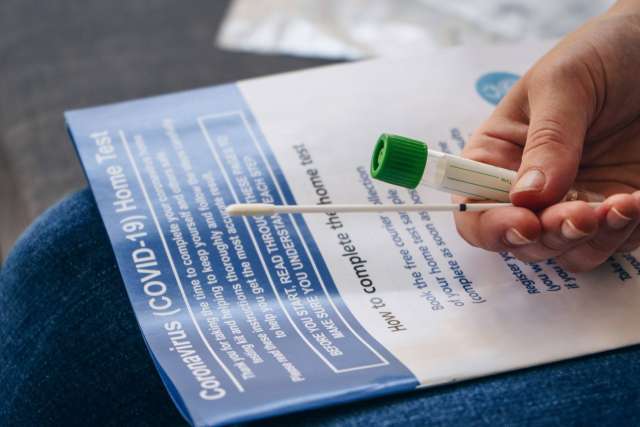Photo: The FDA, on Nov. 17, approved the first rapid COVID-19 home test kit for emergency use.
Patients who use new at-home COVID-19 testing kits will benefit from convenience and speedy results, but with trade-offs in accuracy.
On Nov. 17, the Food and Drug Administration granted emergency use authorization for the first rapid test that can be done fully at home and provide results in 30 minutes. The Lucira COVID-19 All-In-One Test Kit will only be available by prescription for patients 14 and older who are suspected to have the coronavirus.
Omai Garner, PhD, director of clinical microbiology for UCLA Health, said more testing is needed, especially as demand surges with the recent increase in cases. He cautioned, however, that people should understand the limitations of performing testing on their own and should use the home tests appropriately.
“If you look at the landscape of testing across the country, we do not have enough of it,” Dr. Garner said. “This has been a common theme, unfortunately, to this entire pandemic. Any way we can increase the overall amount of testing in a strategic way is going to be an overall positive in fighting this disease.”
The newly approved molecular test is less accurate than the gold standard of PCR (polymerase chain reaction), which can only be processed in a lab. Molecular testing performs well among symptomatic patients, but is far less reliable for pre-symptomatic or asymptomatic people, Dr. Garner said.
For symptomatic patients tested within the first five days of symptom onset, the molecular test is about 90% accurate vs. the PCR at 95%. However, for those without symptoms, the molecular test may be only about 70% accurate while the PCR is about 90% accurate.
“We need an accurate result and then we need people to follow up on that accurate result appropriately,” Dr. Garner said. “If people are positive, they need to isolate. If it’s negative, people need to be sure that it’s negative.”
But in some cases, the reduction in accuracy could be offset by speed. At UCLA, PCR test results typically come back in less than 24 hours, but other labs may take two or three days. At some points in the pandemic, Dr. Garner heard of overwhelmed labs taking up to two weeks to return results.
“Is a home test better than waiting 14 days?” Garner said. “We have to make sacrifices because there just isn’t enough testing.”
Proper usage
In order to use the new test, Dr. Garner said patients must swab inside the lower part of their nose and put the sample in the test unit. Instructions should be as simple and clear as possible to avoid mistakes in administering the test and interpreting results.
“When you have people who have the least amount of experience, you’re open for lots of things to go wrong in the testing process,” he said. “Anything that goes wrong potentially leads to a false negative or false positive result.”
Dr. Garner said the newly approved tests should not be used to gain a false sense of security or as a way to loosen public health recommendations regarding mask wearing and social distancing.
For instance, Dr. Garner said they should not be used as a precursor for risky behavior, such as someone saying, “’I’m having a party and I’m inviting over 15 of my closest friends and if everybody is negative we’re not going to wear masks and we’ll be inside.’”
The test manufacturer also points out that negative results do not preclude infection, noting that people who continue to experience symptoms of COVID-19 should seek medical care.
At-home PCR coronavirus collection kits are also available, but after people collect a sample they still must send it to a lab. That option could eliminate wait times at testing sites such as Dodger Stadium but users will still have to wait for the lab to provide their results.
A third category of tests, rapid antigen, are not approved for home use. They are also the least accurate type of test.
Dr. Garner said people don’t need to worry about fraudulent or inaccurate test kits because the FDA is stringently regulating the testing market.
For people who need to be tested, Dr. Garner said the best choice is still a medical setting, as long as there’s a good turnaround time. However, he said health care systems likely will be quickly overwhelmed in the winter months and may not have enough capacity.
He said developing a national testing strategy is important to deploy the various kinds of tests.
“Let’s use home testing where it’s most effective,” he said. “Let’s look at all these modalities and use them all. We need to know where the tool can be used, know its accuracy and use it appropriately.”
Courtney Perkes is the author of this article.
Related articles
What you need to know about COVID-19 vaccines
UCLA infectious disease experts tout critical role mask wearing plays in limiting spread of COVID-19



